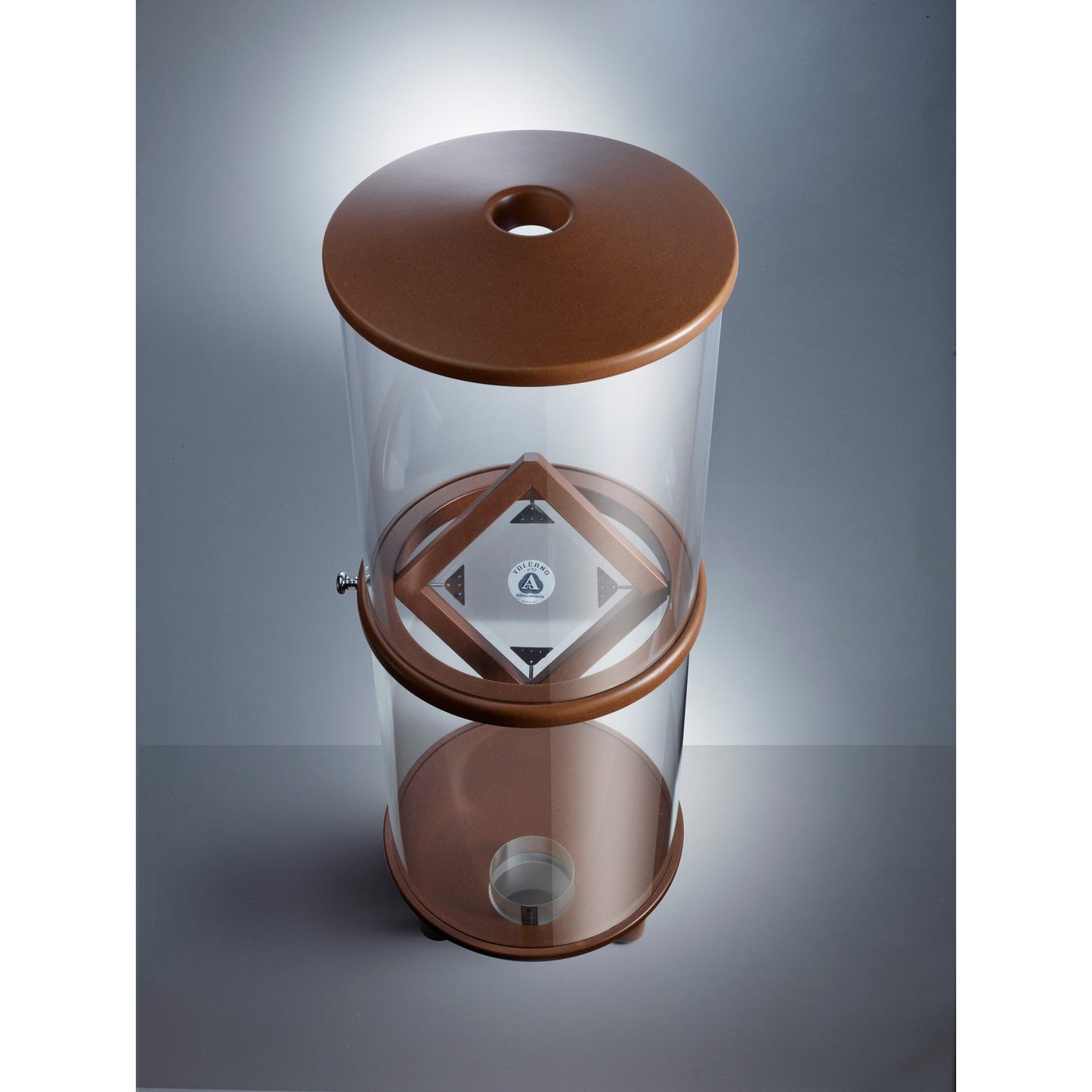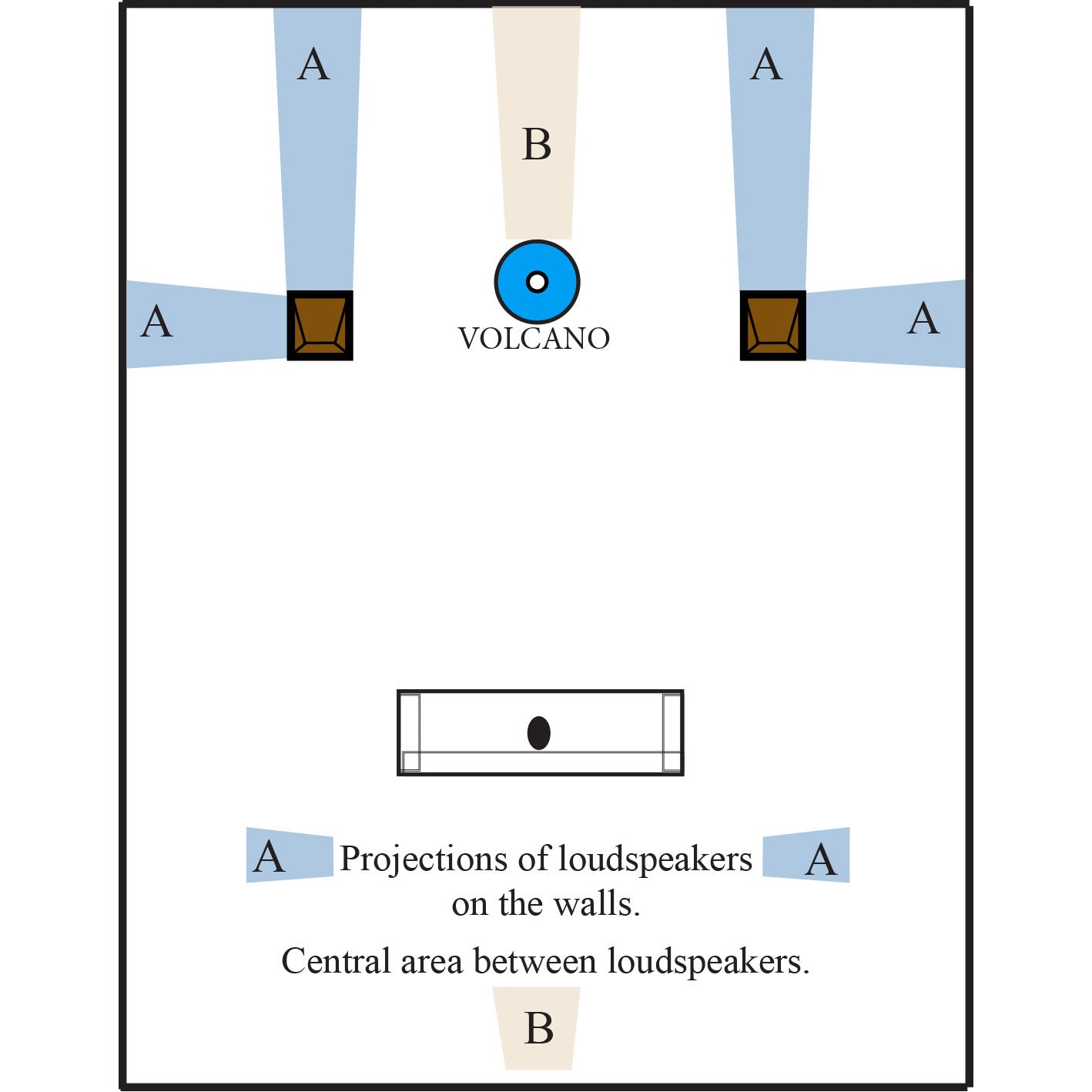1
/
of
19
Acustica Applicata
Acustica Applicata Volcano Room Correction
Acustica Applicata Volcano Room Correction
FREE 5 YEAR WARRANTY INCLUDED
FREE 5 year warranty included on this item
Regular price
£2,100.00
Regular price
Sale price
£2,100.00
Unit price
/
per
VAT included.
Couldn't load pickup availability
Part Exchange / Trade In Quote?
Part Exchange / Trade In Quote?
Priced Singly
Standard Volcano (2 parts): 102 cm (40”) total height x 38 cm (15”) diameter.
Additional Plexiglas module with wooden flange: 42.5 cm (16.7”) x 38 cm (15”) diameter.
VOLCANO is the newest addition to the family of variable resonators developed and manufactured exclusively by Acustica Applicata. It is a device specifically designed to improve the timbre and dimensionality of virtually any music reproduction system in any listening environment.
Not simply a corrective tool, Volcano is able to extract the inherent dimensionality encoded in a recording by flexibly tuning out conflicting sound waves which distort the musical presentation. For those seeking a refined and detailed sound stage presentation combined with “Live” dynamic textures, Volcano is the clear choice.
In a given listening room there are two or more loudspeakers which produce sound pressure within a space bounded by walls. The loudspeakers produce energy fields which only partially arrive at the listening position directly. A significant percentage of sound reaches the listener with variable delays after having bounced off of walls, floor, and ceiling, while also having re-passed through the area occupied by the loudspeakers. This all creates distortions and a confused sound picture.
Additional Plexiglas module with wooden flange: 42.5 cm (16.7”) x 38 cm (15”) diameter.
VOLCANO is the newest addition to the family of variable resonators developed and manufactured exclusively by Acustica Applicata. It is a device specifically designed to improve the timbre and dimensionality of virtually any music reproduction system in any listening environment.
Not simply a corrective tool, Volcano is able to extract the inherent dimensionality encoded in a recording by flexibly tuning out conflicting sound waves which distort the musical presentation. For those seeking a refined and detailed sound stage presentation combined with “Live” dynamic textures, Volcano is the clear choice.
In a given listening room there are two or more loudspeakers which produce sound pressure within a space bounded by walls. The loudspeakers produce energy fields which only partially arrive at the listening position directly. A significant percentage of sound reaches the listener with variable delays after having bounced off of walls, floor, and ceiling, while also having re-passed through the area occupied by the loudspeakers. This all creates distortions and a confused sound picture.
If we observe this scene from above and consider the room not as a 3Dimensional volume but as a liquid 2Dimensional surface, we can greatly simplify our visual example. Think of the surface we are looking down on as a kind of rectangular swimming pool.
Now imagine two identical balls which fall into the pool symmetrically, away from its walls, one on the left and one on the right. These points of impact represent the locations in which the loudspeakers are found in a listening room. It’s easy to visualize the entry of each ball causing a circular ripple which expands outward from the points of entry.
The waves spread, expanding outward until reaching the swimming pool walls. Where each wave reaches a wall, a new wave will be generated in the opposite direction. This secondary wave will superimpose upon or nullify the previous wave. What we have described occurs at the boundary where the wave encounters an obstructing surface, but obviously the two circular wave flows will propagate toward the middle of swimming pool, where they will also ‘crash’ into each other. In this case the two wave flows will interact, transforming them into something other than the original waveforms.
Now imagine two identical balls which fall into the pool symmetrically, away from its walls, one on the left and one on the right. These points of impact represent the locations in which the loudspeakers are found in a listening room. It’s easy to visualize the entry of each ball causing a circular ripple which expands outward from the points of entry.
The waves spread, expanding outward until reaching the swimming pool walls. Where each wave reaches a wall, a new wave will be generated in the opposite direction. This secondary wave will superimpose upon or nullify the previous wave. What we have described occurs at the boundary where the wave encounters an obstructing surface, but obviously the two circular wave flows will propagate toward the middle of swimming pool, where they will also ‘crash’ into each other. In this case the two wave flows will interact, transforming them into something other than the original waveforms.
We have described two simple circular waves within a circumscribed space which very quickly lose their original features warped by collisions between themselves or against exterior boundaries, traveling in the swimming pool until their gradual disappearance. Music is considerably more complex than a simple wave. The behavior just described is extremely simplified, since it is that of a single low frequency wave. Low frequencies generated by an HiFi system are of a vastly more complex structure than a single 2Dimensional oscillatory motion. There are two reasons for this: First, many waves (frequencies) are involved simultaneously. Second, the two balls which fall into the water are rarely of the same size/weight, so each point of wave generation produces different energies at various frequencies. This complex system of wave interactions increases the distortion product within the room itself as wave collisions increase. There are five points within any listening room where this phenomenon becomes extremely significant: Two are found along the lateral walls between the loudspeakers and the listening position. The other two are found near the loudspeakers along the wall behind them. The most important position is found between the loudspeakers, in the middle of soundstage.
This because turbulence created where waves collide creates crucial cancellations. By intervening at this point with a tuned acoustic device, significant increases in waveform clarity can be achieved.
The result is a clear improvement in impact and depth of low frequencies, an increased 3Dimensional representation, along with significant tonal balance correction. Perceived average volume will also increase, but above all else, dynamic contrasts become startling. In its standard configuration, VOLCANO is 105 cm. tall (41”), with a diameter of 38 cm. (15”). The body is transparent Plexiglas, with end caps in wood uniquely shaped to a specific design. VOLCANO is effective down to 35 Hz (with the additional module, down to 25 Hz).
The base contains a port of 10,5 cm. (4,1”) diameter, and within it a cylinder mated to a special acrylic layer, by which (simply pulling or pushing up and down) tuning of the device resonant frequency is achieved. The height of this cylinder within the Volcano tunes it to obtain the best depth and speed of the low frequencies within the room. This adjustment method was inspired by a device used by lute builders at the beginning of ‘900; its name was Tornavoz and was used to increase the sonorous projection and low frequencies of their musical instruments. Utilizing a significant low frequency content music track, the cylinder is moved up or down until speed and depth of low frequencies is maximized: it is easy to hear the sonic differences.
A few changes of height with the same track will determine the best tuning for the bass frequencies, in the position being tested, for the listening room and the audio system being used. There is a scale on the cylinder that allows the listener to raise and lower it with accuracy during the listening tests. In the middle of VOLCANO is a membrane which can be oriented between a vertical and horizontal position. It consists of a wooden frame with a membrane of special acoustic material, adjusted by an external knob. This feature provides control over high frequency diffusion and integration.
The vertical position give more texture and sweetness to the high frequencies, whilst the horizontal position gives more body to the mid frequencies. In most applications, somewhere between the two is tuned to taste.
VOLCANO is sealed on a wooden ‘summit’ with a ‘crater’ in the center. This top part, shaped like a crater with a hole in it, is the inspiration for the name. The underside of the top is a shallow curve of very specific shape. This curved shape, the diameter and shape of the crater are of fundamental importance and essential to the performance of the Volcano.
These parameters have been extensively studied by Acustica Applicata, going through several prototypes and hundreds of hours of listening and measurement tests.
The standard VOLCANO is in two parts: the upper and lower part are linked by a round wooden flange, which supports the orientable internal membrane. These parts are not glued together but are plugged into their working position by round tracks carved into the wooden flange; this allows easy access to the internal chamber for cleaning or adjusting the position of the tuning tube in the base (it is also possible to adjust this tuning port from the outside from underneath the base). Furthermore, this allows the stacking of additional extension Plexiglas modules, increasing the internal volume and lowering the resonant frequency (down to 25 Hz); this can extend the use of the taller Volcano to corner positions in large rooms or attic spaces with angled ceilings or that are mansard shaped.
Assembly. VOLCANO arrives packaged as a single integrated piece (same size as a DAAD4). The two sections are separately packed inside. First the lower section is placed in its suggested position, with the upper part of VOLCANO placed on top, paying specific attention to engage the Plexiglas tube within its groove on the wooden flange, linking the two parts. No fixing or gluing is required.
Suggested positions for VOLCANO
In a given listening room there are mainly three/five places where VOLCANO can be placed:
- two are in the area closest to loudspeakers along lateral walls;
- two are in the area closest to loudspeakers along the wall behind them;
- however, the most important is between the loudspeakers
at the middle of soundstage.
Obviously, the suggested positions along the walls can be shifted considering the available space; the important thing is to remember that those are (together the corners of the room) the points where exists the higher level of sound pressure, so they are perfect to place an acoustic device which works on sound pressure, like Polifemo, Volcano and DaaD.
Share



















Buy with Confidence
OVER 10,000 happy customers
























